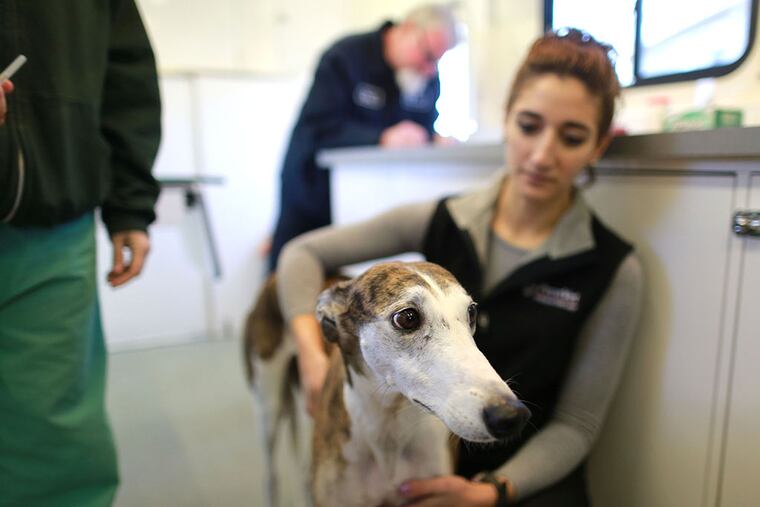Canine blood drives help save other dogs
Holly, a 5-year-old greyhound, barely flinched as the needle was inserted into her jugular vein. Veterinary technician Kym Marryott turned on the pump, drawing a stream of blood through plastic tubing as the dog's owner, Burke Meyers of Pottstown, steadied Holly's slender head with one hand and stroked her flank with the other. "Good girl," he said.

Holly, a 5-year-old greyhound, barely flinched as the needle was inserted into her jugular vein.
Veterinary technician Kym Marryott turned on the pump, drawing a stream of blood through plastic tubing as the dog's owner, Burke Meyers of Pottstown, steadied Holly's slender head with one hand and stroked her flank with the other. "Good girl," he said.
Holly wasn't sick, and Meyers was smiling. The dog is one of more than 200 regular blood donors at the bloodmobile of the University of Pennsylvania Veterinary School.
Every week, the van can be seen somewhere in the Philadelphia area, collecting blood donations for ailing or injured dogs that could not survive without them. It is the only canine bloodmobile in the country.
The rationale is simple. "If people donate for other people," says Donna Oakley, director of operations for the blood bank, "why wouldn't animals donate for other animals?"
The rewards are tangible and intangible. The dogs get a 40-pound bag or a case of canned dog food at each donation, and a yearly blood workup. And if they can't formally consent to the program, they at least have a right to refuse: If they squirm or resist the needle, they aren't forced to donate.
"That would be too dangerous," says Marryott. "The owner is the most important person" in the procedure, she adds. They must calm the dogs during the donation, which usually lasts about three minutes.
That's much less time than for humans because dogs can jump right up afterward without getting dizzy: Their hearts and heads are about the same height, so blood doesn't drain from the brain.
Otherwise, the procedure is essentially the same whether you're four- or two-legged. "It's all borrowed from human medicine," says veterinarian Beth Callan, medical director of the Penn Animal Blood Bank.
Dogs, like humans, have blood types, either eight or 13, depending on classification. The blood bank seeks dogs with type DEA 1.1 negative, which almost all dogs can receive.
More than 50 percent of dogs are DEA 1.1 negative, but almost all greyhounds are negative, one reason that they are perhaps the most popular breed for donations. They also have short hair, making the jugular vein easy to get to, and usually a calm disposition.
The blood bank will accept donations from any breed, with a few exceptions, such as pit bulls, which are susceptible to a blood parasite that requires special screening to detect.
Donor dogs must weigh from 55 to 150 pounds and be in excellent health, with all required shots, to be considered. They must be from one to six years old, although dogs can stay in the program through age eight.
Dogs can donate every six weeks and the owners must make them available three or four times a year to offset the cost of screening and other services. The screening takes about 20 minutes for a first-time donor.
Oakley said the hospital had run an animal blood bank since the mid-1980s, when Penn got a grant from the National Institutes of Health to build a transfusion curriculum. (The hospital also transfuses cats, but the blood is collected from donor cats kept there rather than in drives because cats must be sedated to donate).
"We ran the first blood drive in someone's garage," Oakley recalled. "We went there with my father's truck loaded with all the equipment."
The first bloodmobile was bought in 1991, and the current vehicle came a decade later, donated by a couple whose golden retriever had been saved by transfusions at the hospital.
Every stop has a coordinator, often an animal hospital or clinic, but the stop where Holly donated was organized by Polly Hornberger of Birdsboro, Berks County. The music teacher has four donor greyhounds.
Holly was first, since owner Meyers had to get to work. Marryott, the technician, drew a small sample from the dog's right foreleg to get a red-cell count from a small machine called a hematron.
Then she and Meyers lifted the dog onto the donation table and she drew the blood. Afterward, another technician, Nicole Esposito, prepared a dog snack. "Her cookies and orange juice," Marryott said, bandaging Holly's neck and affixing a heart-shaped red sticker saying "U of P blood donor" to her forehead.
Meyers wasn't reluctant to put Holly in the program. "We [humans] give blood and it doesn't hurt," he said. "It makes me feel proud that this can save so many animals."
How to Donate
To see if your dog can be a donor, call the Penn Animal Blood Bank at 215-573-7222. It seeks dogs with type DEA 1.1 negative, which includes almost all greyhounds. Pit bulls are not accepted because they are prone to a blood parasite. Owners must make their dogs available three or four times a year for donation to offset the cost of screening and other free services.EndText